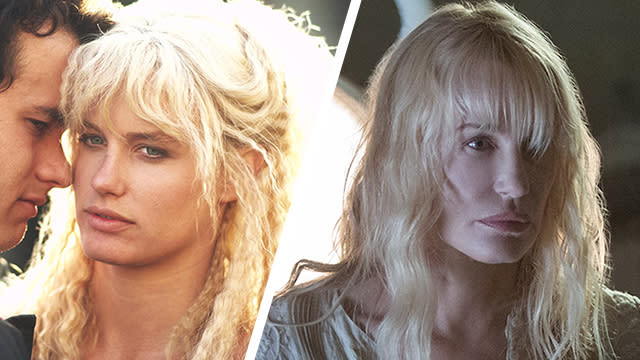How Daryl Hannah Stole Our Hearts, From ‘Splash’ to ‘Sense8’
When I was growing up, many celebrities I liked were lost on my parents: No matter how hard I tried, they never appreciated Pee-wee Herman, Corey Haim or Lisa Lisa and Cult Jam as much as I did.
Every once in a while, though, an entertainer comes along that grownups can dig along with their kids. And though Daryl Hannah rarely gets placed in this category alongside her former co-stars like Tom Hanks and Steve Martin, I’d say she belongs there.
I’ve been watching Hannah onscreen for more than 30 years, ever since my dad brought home a VHS copy of Splash. When people mention the movie today, it’s often in relation to Hanks -- Splash was his first film role -- or Ron Howard, a young director still best known as Richie Cunningham and Opie Taylor.
But without Hannah’s particular blend of awkwardness, humor and vulnerability, Splash would’ve been a very different mermaid movie. (Her performance earned her the Saturn Award for best actress, an honor she shares with Sigourney Weaver, Jodie Foster, Jennifer Lawrence and other strong ladies of sci-fi/fantasy.)
At the time of Splash’s release, Entertainment Tonight talked to Hannah, then 23. Like Hanks, she was cheerful and compellingly likeable. Unlike Hanks, her shyness is glaringly apparent -- and is something I could certainly identify with as a girl:
Almost 20 years later, Hannah revealed that “debilitating shyness” was part of her lifelong struggle with autism.
"I've never been comfortable being the center of attention," she told People. "It's always freaked me out." While Hannah’s discomfort eventually led to her decision to pull back from Hollywood, I think it was also part of her attraction to moviegoers, whether they were 7 (like myself) or 70.
In 1987, I watched as Hannah held her own against Martin in his Cyrano de Bergerac adaptation, Roxanne. The Washington Post’s Hal Hinson called her “the silent-comedy dream girl” who fit in with Martin’s Charlie Chaplin- and Buster Keaton-inspired tone. Roger Ebert called her character “a sweet, gentle foil” to the lead -- not an easy task when your co-star’s prosthetic nose is designed to steal every scene:
What’s funny, though, is that while I was growing up with these characters, older generations were warming to Hannah in a completely different string of roles. As Pris in 1982’s Blade Runner, her intensity and severe appearance command the screen. Remember how Pris’ story ends? (If not, spoiler below …)
She shared top billing in big-budgeters like Wall Street and Legal Eagles, but she also shined in critical faves like The Pope of Greenwich Village. Even in the lesser-known, kinda bad movies -- late-night cable staples Summer Lovers and Reckless among them -- she was often the bright spot, giving us not just a pretty face but a hopeful, energetic human connection.
And sure, Clan of the Cave Bear got abysmal reviews, but I kind of love Hannah for taking on a role where she a) wasn’t relegated to just The Girlfriend; b) spoke in grunts and sign language; and c) ran around for 90 minutes with unwashed hair.
By the time Steel Magnolias rolled around in 1989, we’d seen several sides of the actress: goofy and poised, innocent and dangerous, beautiful and doused in mud. And then … well, then came the ‘90s.
Hannah’s mid-career slowdown caused her to slip our minds for a bit. (Her most popular parts during the ‘90s were probably in Grumpy Old Men and Grumpier Old Men because, you know, Hollywood thinks 30-something actresses only appeal to senior citizens.) During that time, the media seemed particularly focused on her romantic relationships, her looks and anything other than her career. Who wouldn’t feel freaked out by that?
But as soon as the decade ended -- and Americans became particularly thirsty for independent cinema -- she returned in layered, mature films like Dancing at the Blue Iguana (2000), Northfork (2003) and Quentin Tarantino’s Kill Bill movies. Then and now, she tried to shift conversations away from her personal life and toward what mattered to her, whether it was working as an activist or seeking out challenging roles.

On Friday, June 5th, Daryl Hannah returns to the screen with Sense8, Netflix’s new sci-fi drama series from the Wachowskis. On the show, Hannah plays somewhat of a maternal character, a distressed woman who “births” eight strangers who become telepathically linked.
The role is small, but it seems like the perfect fit -- mysterious, strange and visceral. Some have tried to paint the actress as a statuesque blonde beauty, but that’s not what I found most appealing about her in Splash, Blade Runner, Kill Bill or most other films on her resume.
“I always felt I was a bit of an outsider,” she told the Sydney Morning Herald last month. “I think that helped me empathize with others who were marginalized or left outside. If I have any gift, that's one I feel I've been given."
Not only is that kind of gift sustainable for a lifetime, I’d say it’s one we can relate to at any age.
Whitney Matheson is a journalist and pop-culture critic who founded USA Today’s award-winning Pop Candy. Follow her on Twitter at @whitneymatheson.
See Kate Upton’s Barely-There Bikini
Kylie Jenner Sizzles in Jacuzzi Bikini Shoot
Brooke Burke & Her Look-a-Like Daughter Pose in Bikinis


